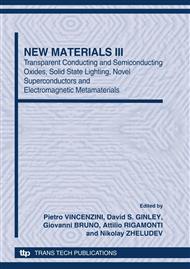[1]
Rotman W., Plasma simulation by artificial dielectrics and parallel plate media, IRE Trans. Antennas Propagat., vol. 10, 82–95, (1962).
DOI: 10.1109/tap.1962.1137809
Google Scholar
[2]
Pendry, J. B., A. J. Holden, W. J. Stewart, and I. Youngs, Extremely Low Frequency Plasmons in Metallic Mesostructures, Phys. Rev. Lett., Vol. 76, No. 25, 4773-4776, (1996).
DOI: 10.1103/physrevlett.76.4773
Google Scholar
[3]
Reynet O., A. -L. Adent, S. Deprot, O. Acher, M. Latrach, Effect of the magnetic properties of the inclusions on the high-frequency dielectric response of diluted composites, Phys. Rev. B 66, 94412, (2002).
DOI: 10.1103/physrevb.66.094412
Google Scholar
[4]
Makhnovskiy D. P., L. V. Panina, Field dependent permittivity of composite materials containing ferromagnetic wires, J. Appl. Phys. 93 4120, (2003).
DOI: 10.1063/1.1557780
Google Scholar
[5]
Makhnovskiy D.P., L. V. Panina, C. Garcia, A. P. Zhukov, and J. Gonzalez Experimental demonstration of tunable scattering spectra at microwave frequencies in composite media containing CoFeCrSiB glass-coated amorphous ferromagnetic wires and comparison with theory, Phys. Rev. B, Vol. 74, 064205-1–064205-11, (2006).
DOI: 10.1103/physrevb.74.064205
Google Scholar
[6]
Zhukova, V, Chizhik, A., Zhukov, A., Torcunov, A., Larin, V., and Gonzalez, J. Optimization of giant magneto-impedance in Co-rich amorphous microwires, IEEE Trans. Magn. Vol. 38, 3090-92, (2002).
DOI: 10.1109/tmag.2002.802397
Google Scholar
[7]
García,C., Zhukov, A., Zhukova,V., Ipatov,M., Blanco, J.M., and Gonzalez, J. Effect of Tensile Stresses on GMI of Co-rich Amorphous Microwires , , IEEE Trans Magn. Vol. 41, 3688-3690, (2005).
DOI: 10.1109/tmag.2005.854809
Google Scholar
[8]
V. Zhukova, M. Ipatov and A. Zhukov, Thin Magnetically Soft Wires for Magnetic Microsensors, Sensors 9(2009) рр. 9216-9240.
DOI: 10.3390/s91109216
Google Scholar
[9]
Smith, D. R., Padilla, W. J. , Vier, D. C. , Nemat-Nasser, S. C., and Schultz , S. Composite Medium with Simultaneously Negative Permeability and Permittivity, Phys. Rev. B, VOL., N0 18, 4184-87, (2000).
DOI: 10.1103/physrevlett.84.4184
Google Scholar
[10]
Panina, L. V., Sandacci, S. I, and Makhnovskiy, D.P. Stress effect on magnetoimpedance in amorphous wires at gigahertz frequencies and application to stress-tunable microwave composite materials, J. Appl. Phys., Vol. 97, 013701-07, (2005).
DOI: 10.1063/1.1821640
Google Scholar
[11]
Makhnovskiy, D.P., Panina, L. V., Garcia, C. , Zhukov, A. P. , and Gonzalez J. Experimental demonstration of tunable scattering spectra at microwave frequencies in composite media containing CoFeCrSiB glass-coated amorphous ferromagnetic wires and comparison with theory, Phys. Rev. B., 74, 064205-15, (2006).
DOI: 10.1103/physrevb.74.064205
Google Scholar


